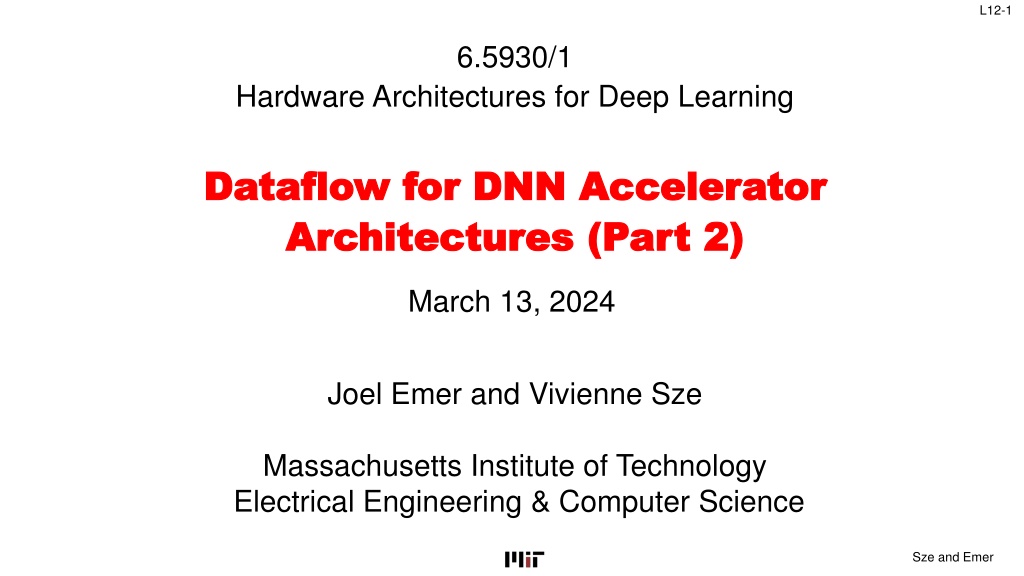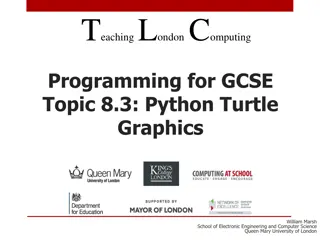
Hardware Architectures for Deep Learning Dataflow - Part 2
Explore weight stationary dataflow for DNN accelerators in deep learning hardware architectures. Learn about weight stationary, convolution operations, and parallel processing through insightful animations and visuals presented by Joel Emer and Vivienne Sze from the Massachusetts Institute of Technology.
Download Presentation

Please find below an Image/Link to download the presentation.
The content on the website is provided AS IS for your information and personal use only. It may not be sold, licensed, or shared on other websites without obtaining consent from the author. Download presentation by click this link. If you encounter any issues during the download, it is possible that the publisher has removed the file from their server.
E N D
Presentation Transcript
L12-1 6.5930/1 Hardware Architectures for Deep Learning Dataflow for DNN Accelerator Dataflow for DNN Accelerator Architectures (Part 2) Architectures (Part 2) March 13, 2024 Joel Emer and Vivienne Sze Massachusetts Institute of Technology Electrical Engineering & Computer Science Sze and Emer
L12-2 1-D Convolution Outputs Weights Inputs = * Q = W-ceil(S/2) S W int i[W]; # Input activations int f[S]; # Filter weights int o[Q]; # Output activations for s in [0, S): for q in [0, Q): o[q] += i[q+s]*f[s] What dataflow is this? Weight stationary Assuming: valid style convolution March 13, 2024 Sze and Emer
L12-3 Weight Stationary - Animation March 13, 2024 Sze and Emer
L12-4 Weight Stationary - Spacetime March 13, 2024 Sze and Emer
L12-5 1-D Convolution Einsum + WS Serial WS design Einsum: ??= ??+? ?? Traversal order (fastest to slowest): Q, S WS design for parallel weights Einsum: ??= ??+? ?? Parallel Ranks: S Traversal order (fastest to slowest): Q Can you write the loop nest? I hope so Sze and Emer
L12-6 Parallel Weight Stationary - Animation March 13, 2024 Sze and Emer
L12-7 Loop Nest: NVDLA (simplified) M = 8; C = 3; R = 2; S = 2 P = 2; Q = 2 int i[C,H,W]; # Input activations int f[M,C,R,S]; # Filter weights int o[M,P,Q]; # Output activations for r in [0,R): for s in [0,S): for p in [0,P): for q in [0,Q): parallel-for m in [0, M): parallel-for c in [0, C): o[m,p,q] += i[c,p+r,q+s] * f[m,c,r,s] Top loops are r and s How can we tell this is weight stationary? March 13, 2024 Sze and Emer
L12-8 CONV-layer Einsum ??,?,?= ??,?+?,?+? ??,?,?,? Traversal order (fastest to slowest): Q, P, S, R Parallel Ranks: C, M March 13, 2024 Sze and Emer
L12-9 NVDLA (Simplified) - Animation M = 2 C = 2 R = 3 S = 3 H = 4 W = 8 P = 2 Q = 6 March 13, 2024 Sze and Emer






















